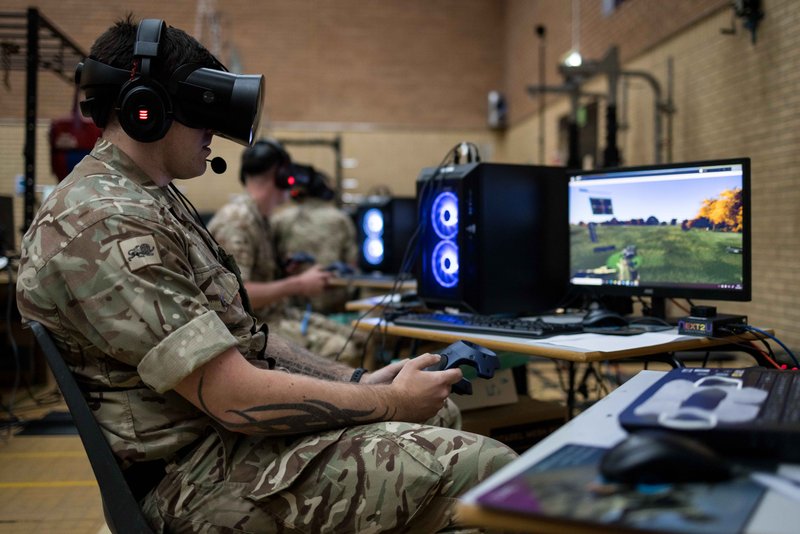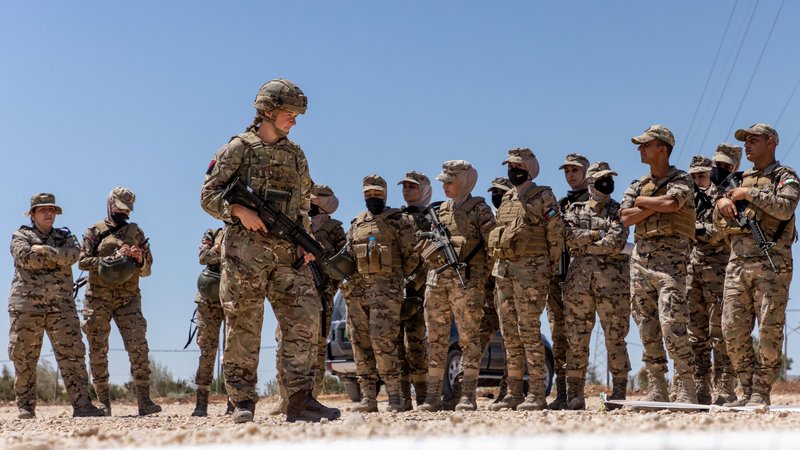Up to the job? Why a fresh approach might benefit UK military training
In an uncertain and volatile world, where increasingly sophisticated and rapidly advancing technology is adding new dimensions to warfare, the need for suitable training to match these demands is becoming ever more apparent.
In an Occasional Paper for the Royal United Services Institute (RUSI) entitled ‘Goodbye Mr Chips?’ Modernising Defence Training for the 21st Century, authors Paul O’Neill and Patrick Hinton recently outlined the challenges facing the UK’s defence training system, identifying four key areas where improvements to effectiveness and efficiency will help to meet this need... Continues below
Newsletter Sponsors:

Above: While greater use of technology is key to providing effective training, this is only one of many factors that the UK’s system needs to consider. (Photo: UK MoD/Crown Copyright)
They highlight the competition for talent, noting that ‘there are global shortages of STEM (science, technology, engineering and mathematics) skills’ and that defence is competing ‘against more flexible and adaptable commercial employers’, although they add that it ‘can recruit untrained personnel and provide them with the right skills, although retaining these skilled people is a different challenge’.

MVRsimulation’s VRSG: bringing military simulation training to life.
According to the paper, ‘the availability of extensive learning and development opportunities is and remains crucial for ensuring the armed forces have access to the skills they need’.
The four key areas identified are:
- improving the training given to those providing the training;
- improving training delivery through greater personalisation, active learning and greater use of technology;
- a better understanding of defence training as a system with clearer lines of accountability, better use of data and mechanisms to enable training to be more responsive to the changing needs of individuals and the organisation; and
- partnering with external organisations that can supply adult education expertise.
The paper identifies problems in the current system, which it says is too fragmented, has a weak feedback loop between operational need and individual training, and is not assessed on the basis of contributing to overall operational output. It also notes that ‘talent’ is loosely defined.
Indeed, the system ‘often struggles to meet the demands placed on it in terms of the need for greater agility in a more heavily committed force whose skills need replacing more often’ and ‘generally takes little account of prior learning or the need for individual learning journeys’. Additional mandatory subjects are often added to syllabuses without cutting other material.

Providing mission-critical training and equipment, this elevated level of innovation can only be provided by the best in the industry. Visit FlightSafety.com.
The paper suggests that the Defence Systems Approach to Training (DSAT) is ‘neither well understood nor properly implemented, and consequently it is slow and overly bureaucratic’. Management of training pipelines is also too bureaucratic, with the result that they slow down.
The current approach to training delivery lacks flexibility and is ‘out of step with shifts… towards skills-based approaches that link training to skills rather than jobs/roles’.
The authors further suggest that ‘the quality of the learning environments in Defence varies greatly’, with poor facilities often used where the benefits of new technology cannot be maximised. And while military instructors may have deep subject knowledge they are less well qualified as instructors, and support staff often receive little training.

Above: While UK military instructors have deep subject matter expertise, the RUSI paper argues that ‘training the trainer’ and related qualifications could be improved upon. (Photo: UK MoD/Crown Copyright)
The paper suggests solutions to these issues, propounding that the ‘single biggest contribution to modernising Defence training could be achieved by upskilling those engaged in the management, oversight, support and delivery of training materials'.
Recommendations are that training appointments should factor in possession of soft skills, tours should be longer to reduce ‘churn’, and that priority of training posts should be raised to ensure they are not ‘gapped’.

Combining with commercial partners who can bring training expertise, the paper suggests, can contribute to these solutions and create greater capacity, but it requires both sides to develop trust in each other.
Addressing delivery, the paper suggests that classroom-based training ‘will remain crucial’, but there is greater scope for online learning, particularly individual pathways based on prior qualifications or experience which can be enabled through technology such as artificial intelligence (AI) and virtual reality (VR).
But accepting the individual pathway approach ‘requires both a cultural shift by Defence and a solid foundation in the basics for the students’, the paper notes.
The paper recommends developing a high-level strategy to consider these factors and suggests that a more dynamic alternative to DSAT would be useful.
It does however highlight some examples of where progress is already being made, notably Project Selborne where the Royal Navy (RN) has partnered with the Capita-led Team Fisher consortium in a 12-year £1 billion deal signed in 2020.
Mutual trust and collaboration
Speaking in October 2023, David Hook, Team Fisher managing director, told the author that mutual trust and collaboration was at the heart of that strategic partnership.
Reflecting the recommendations of the RUSI paper, one of the aims of Selborne is to modernise and improve the learning environment. Hook said that 66 modernised classrooms had been installed at five major RN training establishments, providing reconfigurable furniture with audio and video capabilities and network connectivity, enabling the delivery of the sort of hybrid and flexible learning identified in the paper.
Hook added that instructor assessment and training has been reviewed, with continuing professional development products available to help instructors improve their skills; data capture is improving to better inform decisions; and a schedule optimisation engine is about to be trialled.
Individual learning paths was identified by the RUSI paper as an important element of modernisation. Hook said that the next phase of Selborne, Epoch 2, ‘is all about an individualised learning journey enabled through the digitisation of the learning environment’.

Above: Some training programmes such as the RN’s Project Selborne are already making progress in leveraging digitisation and modernising learning environments. (Image: Capita/Kongsberg)
This will begin in April 2024 and, depending on RN investment decisions, could include more modernised classrooms and a learning device issued to every trainee, depending on the course, with digital content available outside the classroom.
While the RN has been addressing some aspects identified by the RUSI paper, the army has been tackling others, notably the definition and management of talent through Project Castle.
Speaking at the Defence Simulation Education and Training (DSET 23) conference in Bristol back in June, Brig James Cook, programme director for Project Castle, explained that the Army Talent Framework (ATF) developed under the project is aimed at quantifying the skills, knowledge, experience and behaviours of every individual in uniform, regular and reserve, on a scale of 1-7 and with 411 possible categories. He added that eventually army civil servants could be included.
Simultaneously job specifications are being written using the same categories and levels. The result will be that individuals will be appointed to roles to which they are more suited because their identified talents match those required for a particular job.
The implication for military training is that those most suitable for training roles can be identified early and will tend to return to the training environment throughout their career, with suitable interludes to add to their operational experience.
They will therefore develop their expertise and knowledge of the adult learning process, and the army will grow a cadre of personnel with the soft skills identified by the RUSI paper as currently lacking.
Commercial partnership is also on the army’s agenda as a critical element of the Collective Training Transformation Programme (CTTP), with a commercial Strategic Training Partner (STP) and the army jointly delivering the new Army Collective Training Service (ACTS).
The aim of ACTS is to transform collective training with better use of resources, collection and exploitation of data, and wider use of modern technology including simulation, all areas identified by the RUSI paper as requiring improvement.
Although there is certainly still considerable room for improvement and modernisation of the UK’s defence training system, in this author’s view remedial action is already in hand.
Don't want to miss out on future Decisive Edge content? Make sure you are signed up to our email newsletters.













